CT angiography helps planendovascular aneurysm repair
CT angiography of the abdominal aorta is a wellacceptedmodality in the evaluation of bothaneurismal and occlusive disease. In patientswith abdominal aorta aneurysms, it has a major rolein all stages of evaluation.
CT angiography of the abdominal aorta is a wellaccepted modality in the evaluation of both aneurismal and occlusive disease. In patients with abdominal aorta aneurysms, it has a major role in all stages of evaluation.
Even though its functions in the diagnosis and surveillance of AAA overlap with those of ultrasound, CTA is the first choice in pretreatment evaluation and sizing as well as in the post-endovascular repair examination for possible endoleaks.
Endovascular aneurysm repair is an alternative to open surgical aneurysm repair.1-3 Endovascular exclusion of aneurysm via EVAR has expanded the number of patients who are safely and successfully treated by excluding pressurized blood flow within the aneurysm sac and avoiding aneurysm growth and subsequent rupture.
The ultimate goal of EVAR is the prevention of AAA rupture and death. Planning an endovascular repair of an abdominal aneurysm relies on CTA imaging to assess not only the aneurysm dimensions but also the vessel morphology.
DIAMETER MEASUREMENTS
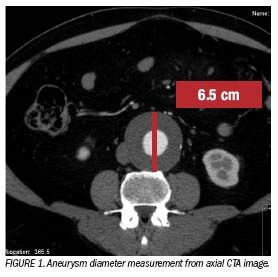
Multislice CT images are acquired isotropically, allowing accurate, high-resolution detail in all planes. This enables confident diagnosis and accurate measurements in all dimensions. Because of the direction of the abdominal aorta, vessel diameter size can usually be measured on axial images. Important measurements evaluated on axial images include aneurysm diameter (Figure 1), proximal neck diameter, and common and external iliac artery diameters.4 These measurements assess both the proximal and distal fixation of the endograft to the native vessel wall as well as the size of the aneurysm and access vessels (Figure 2). Tortuous anatomy may require centerline reconstructions to accurately measure a true vessel diameter.
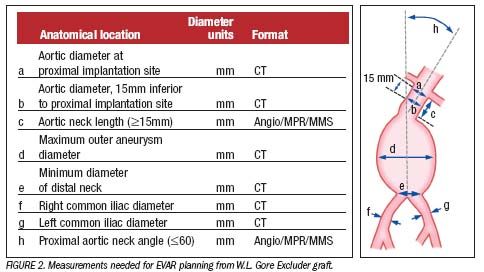
Along with the diameter measurements, the morphology of the aneurysm and the access vessels is also important. Calcification and thrombus within the fixation site may decrease the effectiveness of the endovascular repair by limiting the ability of the grafts to properly seal, thereby increasing the risk of a type 1 endoleak. Calcifications within the access vessels may decrease vessel elasticity, increasing the risk of rupture during endovascular repair.5
The amount of tortuosity within the iliac (access) vessels increases the risk of complications during endograft deployment.6,7 Catheter angiography may underestimate the size of an aneurysm by not demonstrating the associated thrombus; CTA, by allowing the evaluation of the lumen as well as the vessel wall, is more complete.
LENGTH MEASUREMENTS
Vessel length measurements are essential for proper endograft selection. In the early EVAR experience, most patients underwent angiography with a calibration catheter to properly assess the length from the proximal landing zone (infrarenal neck) to the expected distal landing zone. Most of these length measurements are now obtained from CTA.
The most common length measurements include the following:
- Length of the proximal neck: determines the length of the proximal landing zone;
- Length from the lowest renal artery to the aortic bifurcation: determines the amount of room that exists for the endograft and the contralateral limb to be exposed;
- Length of both common iliac arteries: determines the distal attachment zone; and
- Length from the lowest renal artery to the subsequent common iliac artery bifurcation: determines the length of the device to preserve the origin of the hypogastric artery on the respective iliac side.
Proper limb measurements prevent placement of a long main body that will deploy the contralateral limb within the ipsilateral common iliac artery. Undersizing the length measurements to the aortic bifurcation may place both limbs within the endosac, making subsequent canulation difficult. Overestimating the overall length of an endograft may lead to inadvertent exclusion of a hypogastric artery.
PROXIMAL NECK EVALUATION
Meticulous evaluation of the proximal neck is critical in proper planning for EVAR. This evaluation is not limited to the diameter and length of the proximal neck. Neck angulation as well as changes in diameter over the length of the neck are important measurements for proper graft selection and subsequent fixation (sealing) in the proximal neck.
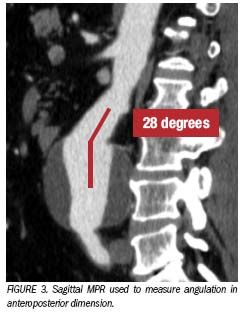
CT angiographic reconstructions allow for length measurements and estimations of neck angle. Maximum intensity projection reconstructions can be viewed in multiple angles to evaluate a neck angle, particularly in complex anatomies where there may be an angle in both the anteroposterior plane and the horizontal (right to left) plane (Figure 3). Using catheter angiography for these measurements would require a large amount of contrast media.
Workstations have facilitated the measurements needed for EVAR planning. Their software programs allow the manipulation of the CTA data set to acquire accurate measurements for endovascular abdominal aortic aneurysm repair.8 These programs allow length measurements using the vessel centerline, a line generated from the center points from the plane perpendicular to the flow lumen throughout the course of the aorta. This measurement should compensate for angulation as well as location of the flow lumen within a partially thrombosed aneurysm (Figure 4).
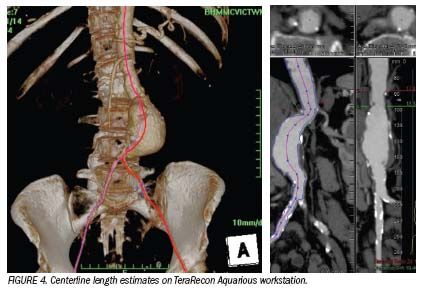
Commonly, the operator determines the locations of the lowest renal artery to the desired distal landing zone, and the programs derive a centerline length. Stent-grafts tend to follow as straight a course as possible, deviating toward the lesser aortic curves, suggesting that the shortest line between proximal and distal landing zone may be the most accurate measurement.9 The centerline measurements, however, are more accurate than estimating the length of an endograft using the table locations from the CT scan,10-12 as these measurements would not allow for horizontal and depth deviation in the remaining two planes of the iliac vessels in their length measurements. Angulation measurements are best performed using MIP reconstructions, while length dimensions are usually generated from centerline measurements.
The initial success of EVAR requires proper planning, which is based on CTA measurements to determine endograft selection and sizing. Computer software programs allow the diameter and length measurements to be recorded in a simple report that can be saved with the patient's hospital record and/or PACS images (Figure 5).
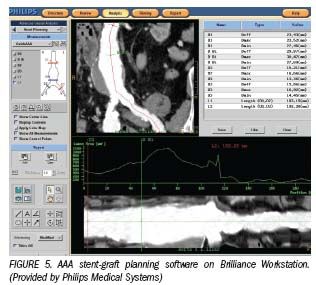
FUTURE IMPORTANCE
Even though CTA for EVAR planning has become accepted over the last few years, its importance will increase in the future. Fenestrated endografts extend the potential proximal seal zone by allowing renal and mesenteric vessels to be spared within the proximal seal zone by creating small fenestrations or windows within an endograft. These visceral vessels can be selected with a catheter and protected with a prepositioned hole or window in the graft material while the endograft is deployed across the proximal landing zone.
Fenestrated grafts increase the stability of the endograft repair by preventing migration and eliminating the potential for initial or delayed type 1 endoleaks in many of these patients with challenging proximal necks. This technique may be used to treat complex thoraco-abdominal as well as iliac aneurysms.13
As the location and size of these vessels are variable, fenestrated endografts create a greater demand on precise imaging. The alignment, positioning, and size of the fenestrations for a particular branch must be carefully determined for each patient. Sizing and planning for fenestrated grafts require detailed vessel diameter measurements as well as accurate distance measurements between each vessel and must show how each orifice interrelates from the specific reference point.
These reference points are usually described as a location from the origin as noted on a clock face. The large amount of detail, including precision angulation measurements as well as interval distances between each individual vessel, is essential for success in the placement of a demonstrated endograft. Additionally, CTA provides critical information regarding visceral artery stenosis and anatomy, which are important to endovascular planning. These measurements will increase the importance of CT angiography as well as 3D workstations in planning endograft treatment.
GE HealthCare Debuts AI-Powered Cardiac CT Device at ACC Conference
April 1st 2025Featuring enhanced low-dose image quality with motion-free images, the Revolution Vibe CT system reportedly facilitates improved diagnostic clarity for patients with conditions ranging from in-stent restenosis to atrial fibrillation.
The Reading Room: Racial and Ethnic Minorities, Cancer Screenings, and COVID-19
November 3rd 2020In this podcast episode, Dr. Shalom Kalnicki, from Montefiore and Albert Einstein College of Medicine, discusses the disparities minority patients face with cancer screenings and what can be done to increase access during the pandemic.
Can Photon-Counting CT be an Alternative to MRI for Assessing Liver Fat Fraction?
March 21st 2025Photon-counting CT fat fraction evaluation offered a maximum sensitivity of 81 percent for detecting steatosis and had a 91 percent ICC agreement with MRI proton density fat fraction assessment, according to new prospective research.